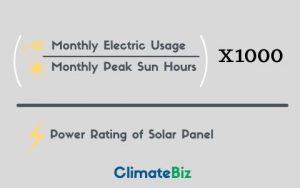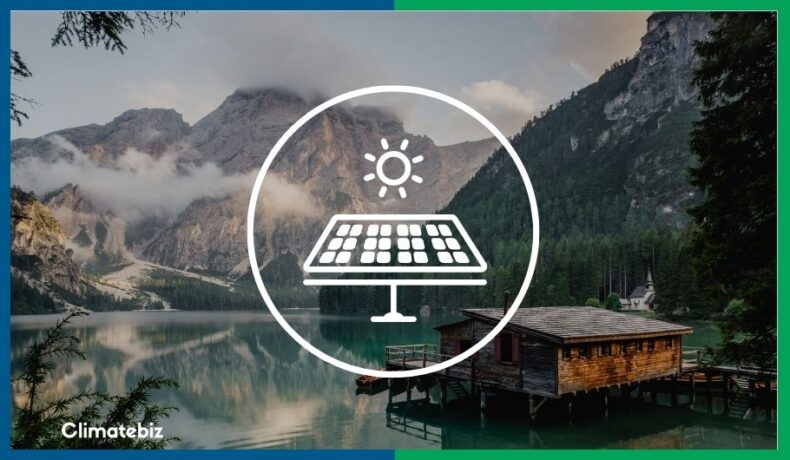So, you’re wanting a solar-powered cabin that has enough electricity to power all your appliances, do you?
Well, we think that’s a great idea! But (and yes, this is a big but) there’s some essential info that you simply cannot skimp out on if you’re wanting to make this investment a success.
In the following article, you’ll learn the fundamentals of owning a solar-powered cabin, including:
- Estimating the total power requirements.
- The equipment you’ll need.
- How you’ll go about setting it all up.
After arming yourself with the above knowledge, we have no doubt that you’ll be one happy cabin owner!
Table of Contents
Can I Power My Off-Grid Cabin With Solar Power?
Yes, you certainly can power your cabin with solar energy, the only requirement is access to sunlight (the more the merrier).
You can use the sun’s energy via solar panels if:
- The roof of your cabin receives direct sunlight throughout the year.
- You own land around your cabin that receives direct sunlight.
The amount of solar power you’ll require all comes down to how much solar you’d like to produce/store. Generally, the power needs of your appliances will dictate this.
Remember
Power is measured in watts -most appliances provide you with this info. If they don’t, you can calculate your appliance’s power requirements by multiplying the required voltage by the required amps: (Power = Volts * amps or P = V*I).
While most appliances require US standard 120VAC at 60Hz – and solar panels only produce a DC voltage – there are DC to AC converters that you can purchase to produce that 120VAC power source.
How Much Solar Power Is Needed For An Off-Grid Cabin?
To determine the amount of solar power you’ll require. Basically, you’ll need to know the number of kilowatt-hours (kWh) that you’ll be consuming each month.
What Is kWh?
A kWh is a measure of energy consumption.
Using a common light bulb as an example – if you have a 100-watt bulb and you run it for 10 hours that is 1000 Wh or 1 kWh of energy usage.
In order to properly run a 100-watt bulb, your solar-powered cabin has to be able to supply 100 watts of power at all times.
If your system doesn’t have sufficient power available, the device you want to run will no longer work.
For this reason, it’s important that you always account for the minimum power threshold required.
With this in mind, you can start to calculate the power requirements of your cabin.
Let’s go through an example (step-by-step). Your cabin will have:
- 4 X 100-watt light bulbs
- mini-fridge
- Hot plate
Step 1: Calculating The Systems Energy Needs
In the table below you’ll calculate your system’s total energy needs.
| Appliance | Power (watts) | Hours per day | Total Wh |
| 4 light bulbs | 400 | 5 | 2000 |
| Mini fridge | 172.5 | 24 | 4140 |
| Hot plate | 500 | 2 | 1000 |
| Total | 1072.5 | – | 7140 |
Remember, to get your kWh all you have to do is divide Wh by 1000.
So, your cabin uses a total of 7,14 kWh per day. Or 214 kWh a month.
Now, the size of the solar system that you’ll require depends on your cabin’s location and the amount of peak sun hours your area receives.
To determine how many solar panels your cabin will need, you can use the following formula:

Step 2: Finding Peak Sun Hours
Now, you already know how much electricity (kWh) your cabin uses, thanks to the above table.
But how many peak sun hours does it receive?
To figure this out you need to use a website called Global Solar Atlas.
We created a quick video to show you what to do:
In our example video, we determined that your cabin receives 5.4 peak sun hours a day.
Step 3: Determining Monthly Peak Sun Hours
But, remember, you still need your monthly peak sun hours.
So, now it’s time to multiply the daily peak sun hours by 30.43 (average amount of days in a month).
5.4 x 30.43 = 164.32 peak sun hours per month.
Step 4: Determining System Size & Number Of Panels
Now you can continue using our formula to determine your system’s size and the number of corresponding panels:
214 kWh ÷ 164.32 = 1.30kW
This means your cabin will require a 1.3kW solar system in order to offset your daily energy usage.
Now, using the formula, let’s figure out how many solar panels that equals:
(1.3kW x 1000) ÷ 300 = 4.3 panels needed for our solar-powered cabin.
How Much Will A Solar-Powered Cabin Cost?
The cost of your solar-powered cabin depends on the answers in the previous section.
Once you know the amount of power your solar panel array has to produce, and how much energy storage you would like, you can determine the overall cost.
Solar Panel Cost
In our example, you used a total of 4x 300-watt solar panels, making for a total of around 1200 watts.
Using the average cost per watt of $2.77 we estimate that your solar panels cost around $3,324.
Battery Storage Cost
Since you want to have the ability to run appliances overnight, your system will require energy storage.
The mini-fridge will have to run all night. Let’s also assume that a light or fan will also be running all night.
At 12 hours of average run time on the battery, you’ll need 3.3 kWh (275 watts x 12 hours) of energy storage, at minimum.
From this number, you can determine our battery storage demands by using the P=I*V formulas in a slightly different way 3,300wh / 12VDC = 275Ah.
Your system will require three of these 12V 100Ah deep cycle batteries, which gives you a little extra energy storage in case it’s needed.
At $225 apiece, your energy storage system will cost you $675.
Charge Controller Cost
Now you need a charger controller that can handle the full current produced from your solar panel array.
Your solar panel array can produce up to 1200watts at 12VDC, which is 100A.
The charge controller will also have to run all of our equipment at the same time.
To be safe, you could use a Victron 100 amp MPPT charge controller ($795).
DC To AC Inverter
You’ll need a DC to AC inverter that can take 12VDC and step it up to 120VAC. It must also handle at least 1075 watts of power.
Unfortunately, there’s a big jump for most AC to DC inverters from the 1000 watt range to the 2000 watt range – the price also doubles.
Because of this, you can use a Renogy 1000 watt DC to AC inverter as there’s little chance of you needing to run everything at full power, all at once.
This will cost $189.
Safety Equipment
It’s important that you have circuit protection to save the system from short circuits during setup.
These products aren’t required to make the solar energy system work, but we highly recommend getting the following items:
- For the solar panels, two 60 amp Circuit breakers.
- For the batteries, at least one circuit breaker on the positive lead. Each battery has a max recommended current of 30A so you should get an additional three 30 amp circuit breakers for these as well.
- A couple of small electrical enclosures just to keep everything dry and in good condition. McMaster Carr is a great place to get small electrical enclosures for cheap, and they already have pre-punched knock-out holes for your wires.
For this, you can use two of these polycarbonate enclosures. In order to mount the circuit breakers in the enclosure, you’ll need a 35mm din rail (which can be found on Automation Direct).
All together these items will cost you just under $120.
Total Cost
The only remaining items that you’ll need are properly sized wires and connectors. For your system, you’ll need 4 gauge wires, which costs $2.27 per foot.
Now to add everything up:
| Product | Cost |
|---|---|
| Solar Panels | $3,324 |
| Batteries | $675 |
| Charge Controller | $795 |
| Inverter | $189 |
| Safety Equipment | $120 |
| Total | $5,103 |
Final Thoughts
Solar power is a very versatile and powerful way to produce electricity.
You can set up a solar-powered cabin to run in a million different ways depending on your energy demands.
You could create a system that doesn’t have any energy storage, and only has energy during the day, or you could create a large battery storage system and run your cabin at full power all night long.

